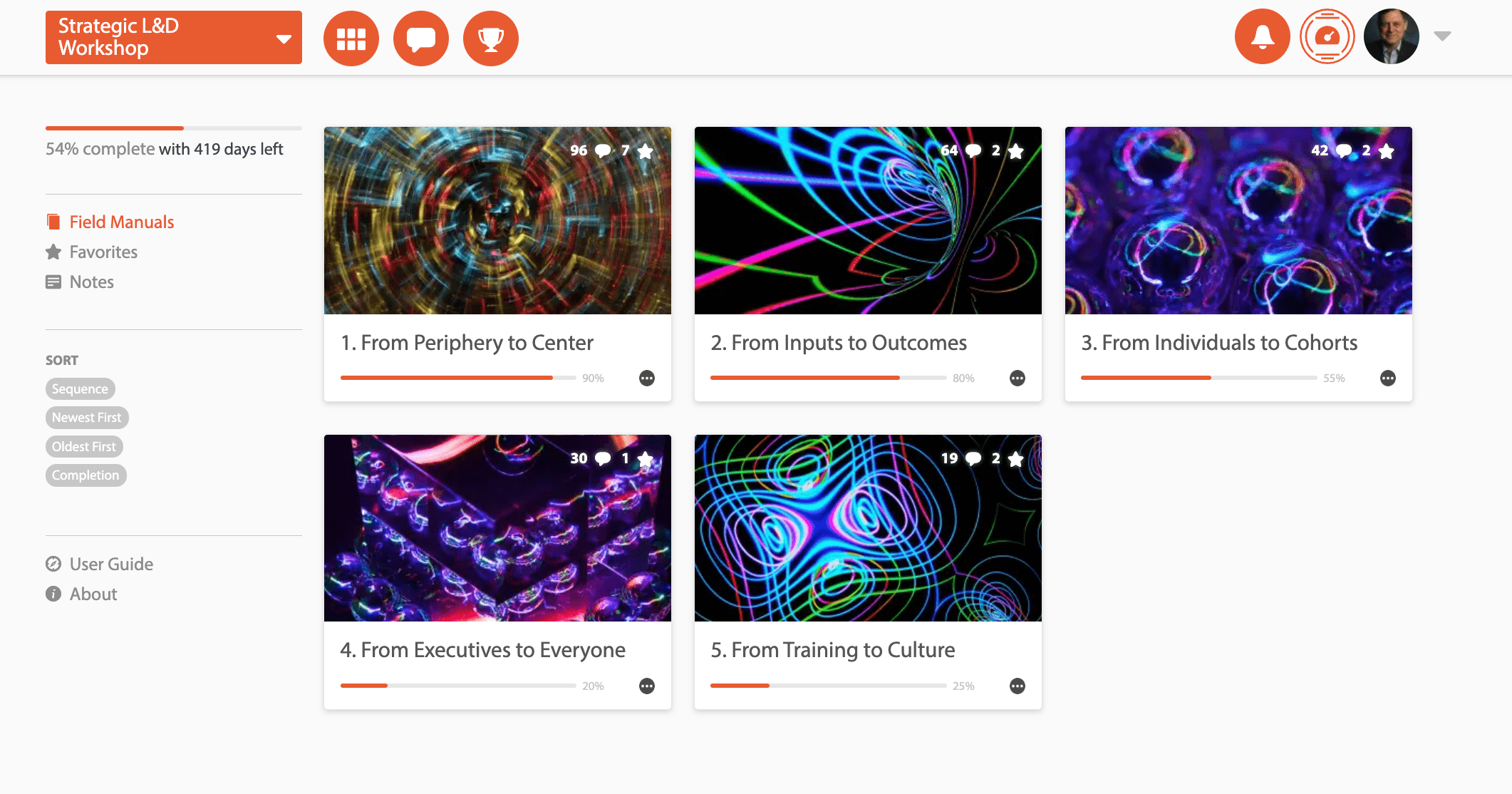Wondering how your peers are making L&D central to their organization’s strategy?
Nov 09, 2023 by Robert M. Burnside
Get Our Newsletter
Sign up to get the latest expert commentary, analysis, and news on enterprise learning and capability academies delivered straight to your inbox.

Summary:
Wondering what senior L&D practitioners are saying about the current evolution of L&D? And how they are transforming it? This summer Nomadic Learning offered free access to its Strategic L&D Workshop, an online cohort based asynchronous learning activity, generally taking a total of 4 to 6 hours of learning time over 5 to 6 weeks. One hundred active practitioners of L&D offered their ideas on how to make L&D strategically central to their organizations. It was a diverse global mix: 29 countries, wide variety of industries, primarily large global companies, but also non-profits and tech startups.
Prefer to download this post as a PDF and read it later? Click Here
Glimpse of the program content:
Here’s what the program looks like on the Nomadic platform, you can gather how it stimulates a conversation about L&D’s evolving role:

Participants’ current ratings of their progress:
Participants’ ratings of their current status of transformation show the L&D function is only partway along its transformation. Where would you rate your organization?
Which of the following best describes how L&D is seen by other parts of your organization today?
- 8% L&D is seen as a distraction from other work
- 50% L&D is seen as useful, but secondary to other work
- 29% L&D is seen as a useful strategic partner, but only by some
- 11% L&D is widely seen as a strategic partner and consultant to other teams
- 3% L&D is seen as a strategic partner and consultant to other teams and to the C-suite
How do most new learning initiatives on your team begin?
- 61% With a request for a specific skill or kind of training
- 22% With a request for a consultation about a bigger problem or priority
- 17% Within the team, based on the discretion of L&D leadership
Do you believe your organization currently has a culture of learning?
- 27% No, we do not have a culture of learning
- 55% No, but I believe that we are making progress in that direction
- 18% Yes, we definitely have a culture of learning
At A Glance: Participants’ ideas on where L&D is now and where it needs to progress
We used Open ai’s ChatGTP4 to summarize the extensive number of comments into common areas of focus, with proactive ideas supporting each focus. We bring the summaries to life by providing participants’ actual comments to illustrate each area.
Here’s a quick summary of the 8 areas of focus with the subsets of the types of comments given by participants:
- Barriers to progress in centralizing the importance of L&D
Effective use of data
Leadership Buy-In and Support
2.Leadership behaviors that promote the strategic importance of L&D
Leadership Advocacy for Learning
Initiatives for Learning
Challenges in Championing and Practicing Learning
- Common blocks to centralizing L&D
Time and Budget Constraints
Accountability and Advocacy
Perception and Value of L&D
- How does L&D help move the organization to using L&D for strategic outcomes?
Probing for Outcomes and Goals
Aligning Training with Organizational Goals
- What are examples of how L&D is helping achieve organization goals?
Organizational Improvement through Learning Initiatives
- What makes cohort-based learning successful?
Types of Skills Suitable for Cohort-Based Learning
Structure and Environment of Cohort-Based Learning
Benefits and Challenges of Cohort-Based Learning
- In what ways is providing learning opportunities for everyone in the organization useful?
Manager's Role in Learning and Development
Accessibility and Inclusivity in L&D
Innovative Approaches to L&D
- What helps build a good learning culture in an organization?
Culture Driven by Values and Integration into Day-to-Day Operations
Interested so far? Read on in the Appendix to hear your peers bring to life in their own words the challenges of centralizing L&D in their organizations. Lots of ideas you can use! Also, this link takes you to our popular summary of why cohort based learning works.
Click here to join Nomadic’s always on free Strategic L&D Workshop and add your voice to the conversation.
Also, click here to register for our free December 5th webinar with Pamay Bassey CLO of Kraft Heinz, Heather Yurko of Mastercard and Matt Burr of Nomadic Learning as they highlight innovations in career development. And stay tuned… coming soon will be another free open workshop on the subject of career development… click here for our newsletter.
APPENDIX
Focus 1 Barriers to progress in centralizing the importance of L&D:
If you don’t feel that L&D is moving to the center of the organization, what are the barriers to that progress?
Effective use of data
- The challenge remains in effectively utilizing data to demonstrate the ROI and align L&D outcomes with strategic business goals. “I think the biggest barrier is to demonstrate the effectiveness of learning programs to senior management. The L&D team at our organization deploys many learning initiatives, offers educational stipends, etc but they are not able to demonstrate the outcomes of all these initiatives and alignment with strategic business goals, making it difficult to prioritize learning to drive change.”
- There is a recognized need to improve in data analytics and shift from mere knowledge and attendance data to more strategic data that underscores business impact. “The realization has hit that knowledge and attendance data aren't enough to prove ROI. We are working on how to provide more strategic data that shows an impact on the organization. It takes time to move in this direction, though.”
Leadership Buy-In and Support
- The involvement and support of senior leadership and C-suite executives are crucial for the success of L&D initiatives. When leadership is engaged, it drives the importance of learning throughout the organization. “We are on a right path, as our C level management realizes the importance of L&D, I am asked to be involved in business critical projects from the beginning to have enough time to design the best learning method and drive change. It is more than just trainings, and the company sees it already. We do need to improve in the data analytics part, to really use our data for planning.”
Focus 2 Leadership behaviors that promote the strategic importance of L&D:
Leadership Advocacy for Learning
- Leadership support for learning not only emphasizes the importance of individual development but also aligns learning with the organization's strategic goals. “Our COO recently announced that he wants us to become a "learning organization" and he is deeply supported by two different presidents among our divisions. We are working to define what it means to be a learning organization and these presidents are championing and piloting new initiatives.” “One of the GMs I work with has been a great advocate, role model and driver of L&D. From ensuring his team is available for courses, encouraging and investing in skills training and celebrating success with the whole team. He even prides himself getting his team through compliance training before anyone else.”
Initiatives for Learning
- While platforms are available, there is a need for L&D to engage fully, emphasizing the importance of fostering a learning culture. “Within our L&D Team, our effort nowadays is focusing at reviewing, redesigning and re-inventing the learning pathways. We strive for alignment around the modern ways of learning which support the core capabilities business is looking for at present and in the near future.”
Challenges in Championing and Practicing Learning
- There are challenges in establishing a learning culture where some employees might not yet be fully engaged or aware of the available learning resources. “The one stop platform is a both good starting point -to find what is out there and available to learners, but it also has a social element for people to contribute and discuss their thoughts on the learning. People are still getting used to the first part. I think there still needs to be a culture change before people become engaged in an interchange of thoughts and ideas.” “I have worked with my HRD to educate managers in the role they play supporting learning. The culture is production focused and performance/learning conversations don't take place. I discovered that managers weren't aware of the learning content and didn't ask follow up question, learning in the flow wasn't supported. We've worked hard to ensure goal alignment to business issues and created manager guides with prompts.”
- Ground-level examples and success stories can be effective in promoting learning, suggesting that peer influence plays a significant role in encouraging learning behaviors. “The "usual suspects" come to mind - where others may say "it's alright for him/her - they have the freedom to plan their week and "take time out" to be curious - the rest of us just have to deliver". For me it will be important to find "ground roots" examples of "people like me" taking small learning steps and benefiting from it. And convincing them to want to be in the spotlight.”
Focus 3 The biggest blocks to centralizing L&D:
Time and Budget Constraints
Time constraints, particularly in organizations that prioritize production or client work, pose significant challenges to centering L&D. “Time is the hardest right now - the business is not willing to protect time for learning, instead saying we have to focus on client work. The connection between what L&D does to iMPROVE client work is being overlooked and I am unsure how else to open this door. Truly feels like we have tried it all.”
Budgetary concerns, although often tied to advocacy, are a recurrent issue for many organizations trying to prioritize L&D. “Currently, the team I lead and the organization I am part of has the will to center L&D. We are also very recently experiencing an increase in advocacy from some of our senior leaders. However, budget, time and accountability are still areas that need improvement. The organization also needs to align on what learning means. We are starting to move in the right direction, but there is still a long road ahead of us.”
Accountability and Advocacy
- There's a noticeable gap between organizational leaders expressing the desire for learning and development and the actual implementation or follow-through, particularly in terms of holding individuals accountable for their learning. “I am slowly but surely teaching my organization how to utilize the training department effectively. I think all categories are reachable the one I see having the most issues with, is getting the backing and support from upper management. They say that they value learning and development but sabotage it when it’s time to hold people accountable. They themselves will wait until the last minute to complete trainings.”
Perception and Value of L&D
There's a degree of ambiguity or lack of clarity about what centering L&D truly means, leading to varying interpretations and efforts. “We are motivated to center L&D but we aren't totally sure what that means! Thankfully we're in a good place with advocacy, but we are definitely being thoughtful about budget and time as we move forward.”
Shifting organizational mindset towards viewing L&D as a continuous and valuable process, rather than an occasional obligation, is a goal for many but remains a challenge. “Making a stronger connection between learning and achieving business and personal development/career goals (therefore also Performance Management) is something we are working on - so that people see learning as a vehicle to success and not something else they need to find time for. It's a mindset shift that's going to take a long time - but will be worth it!”
Focus 4 How does L&D help move the organization to using L&D for strategic outcomes?
Probing for Outcomes and Goals
There's a recognition of the importance of understanding the true goals and objectives before committing to a particular training activity. “As a service provider, I am often approached with a set of competencies on which the organisation wants their leaders to be trained. But when we ask what is the outcome they want to achieve? What do they want the leadership program to deliver as business value, the conversation shifts and we mostly end up with a different set of focus areas. Inputs vs outcome thinking is a transition that many need to make.”
Organizations often approach L&D with a preconceived solution, but through probing questions, it's often revealed that the initial request might not address the actual business problem. “We often get asked to facilitate DiSC or Strengths workshops. This is truly our most frequent request, and it is an input. Whenever I get a request like this, however, I ask them what their goal is with the session. Is it pure teambuilding? If so, an activity might be more appropriate. Is it cohesion to allow for better customer outcomes? I try to dig to the root of the issue FIRST before committing to anything.”
Aligning Training with Organizational Goals
- Employees and leaders often have differing views on what competencies are lacking, highlighting the importance of assessments like competency gap analysis. “We keep getting requests for craft/technical skills training, but when we pull the competency gap analysis, most learners rate themselves as competent in their craft/technical skill, but needing development in their power skills. It's interesting to see how the leader's perspective doesn't align with the learners self-identified competency.”
Focus 5 What are examples of how L&D is helping achieve organization goals?
Organizational Improvement through Learning Initiatives
- Focus on Soft Skills and Adaptability: A significant number emphasize the importance of soft skills such as active listening, communication, coaching, storytelling, and feedback. These skills are considered essential for achieving various outcomes, from adaptability and employee engagement to performance management and customer satisfaction. “Outcome: Increase retention and reduce disciplinary and Grievances. Learning initiative: Introduce Line manager training Skills/capabilities and competencies: - focused on effective management principles, communication, coaching, development, performance management. Data: Retention - Employee engagement surveys and pulse surveys, recruitment and onboarding data, How are we doing check-in data (week 1, 4, 12, 24, 52). Disciplinary and Grievance data, investigation data, whistleblowing data. Action plans from cohorts. Evidence of performance management conversations, mentoring and coaching.” *“Across all the functions and organizations in our company, we are currently focusing at Adaptability. We are aiming at breaking the siloed approach to problem-solving via fostering cross-BU collaboration, end-to-end thinking, making sense of information, interpreting data to make well-informed decisions, allowing data to tell the story, looking around the corner, striving for resilience in constantly changing and extremely dynamic environment. As for the measurement, we are still refining ways how to measure effectively.”
Focus 6 What makes cohort-based learning successful?
Types of Skills Suitable for Cohort-Based Learning
Cohort-based learning is highly effective for skills that require an identity or behavioral shift, such as leadership training, communication, active listening, and emotional intelligence. “I think "mindset" capabilities are best learned in cohorts to help shift thinking. An example of this is moving from a closed mindset to a growth mindset, or from a diminisher leader to a multiplier leader. This can enrich perspectives and aid in reflection.”
Immediate feedback and peer learning are pivotal in cohort settings, especially for skills like sales training, coaching, and influencing. “In my experiences, I found cohort learning very useful for sales training, especially when individuals were learning how to put their pitch together and had an opportunity to work on it in a small group.”
Structure and Environment of Cohort-Based Learning
A well-structured and nurturing environment is crucial for the success of cohort-based learning. Clear expectations and a sense of community are essential. “The collective learning is efficient if the cohorts are formed intentionally and smartly. This way a group of people comes together who share common experience, are at the same /similar level of expertise, or follow the same objective by taking part in the learning. On the contrary, the courses with random enrollment face the risk of mixing people at various levels, what makes it hard to engage & share knowledge.“
The role of the facilitator is paramount. Their ability to create a dynamic environment, foster open communication, and ensure inclusivity can make or break the cohort learning experience. “In order to spark interest of the cohort members in other parts of the organization and get better understanding of the complexity of issues and business problems, the social interactions among participants have to be intentional and well-designed - it is very true that they don’t happen easily and naturally. Peer relationships needs to be encouraged and fostered over time, since it is a process that requires investment of time and effort from all parties involved to eventually reap the fruit.“
Benefits and Challenges of Cohort-Based Learning
1. Cohort-based learning offers numerous benefits, including peer learning, networking opportunities, and a platform for collective growth and reflection. “Cohort Learning will provide learners, in this case managers, a safe environment to learn, test and try the language required to drive digital transformation. An opportunity to practice before facing their employees. It also will provide them with a group of peers to ask questions and a single location to refer back to.”
Focus 7 In what ways is providing learning opportunities for everyone in the organization useful?
Manager's Role in Learning and Development
Managerial support directly impacts the effectiveness of learning initiatives. “Theory: "everyone should be lifelong learning". Reality: Very different accessibility (starting with whether you have a company email address or not) and "eligibility" based on your manager's assessment of the situation and your own sense of security to "admit" you need to learn and/or "take time" to learn.”
There's a need to evaluate and train managers to ensure they prioritize and facilitate L&D within their teams. “Without a managers support, encouragement, follow-up and reinforcement learning events can fail. It's imperative that managers at all levels are equipped with the necessary skills to enable their teams to grow. Managers in my org are often internally promoted, which is great, however lack management skills. My role has been to using technology provide bite-size, just in time development to support their growth.” “Definitely believe, that learning should be democratized and made available to all. And managers should play vital role in inspiring people to learn more and grow. Knowing the reality, managers often look only at performance and push for better productivity, often deliberately ignoring a strategic view of improved results learning brings in the long-term. Yet, that is not reflected in their bonuses.”
Accessibility and Inclusivity in L&D
- True democratization of learning requires rethinking how learning opportunities are distributed and making them available to all. “While we do have learning available to everyone, our most highly coveted programs (with the highest cost to the org) are only available by invitation only and are only offered to the C-suite execs. 80% of the budget and L&D focus is on those programs that serve less than 10% of the learner population. If we could flip that, imagine the difference we could make and the impact on the learner journey for the other 90%!”
Innovative Approaches to L&D
Peer coaching and capability academies are emerging as effective tools for democratizing learning. “The most leveraged tool within 'learning for all' are the Capability Academies. All employees are assigned a core course(s) that they have to complete within a year, and they can also select elective courses based on their needs and preferences. These academies are well utilized, yet, if promoted regularly within the org, the enrollment in electives could be even higher. The best example of learning brought from the execs realm to wider population (not all yet) is access to professional coaches via coaching platforms. This is a real game-changer.”
There's potential in creating user-generated content and platforms for sharing knowledge and experiences. “We have embedded coaching into all of our management programmes, as well as stand alone. Our core skills workshops are available as one-day, intro to 60-minute workshops and e-learning - To ensure we can support colleagues as and when they need it. It would be good to introduce mentoring and coaching for more people. And also user generated content to sit on the LMS.”
Focus 8 What helps build a good learning culture in an organization?
Culture Driven by Values and Integration into Day-to-Day Operations
- For a learning culture to be truly effective, the organization's values and learning objectives need to be familiar to all members and consistently modeled in behavior. “To us, culture is shaped by our values and demonstrated by our day-to-day actions, behaviors, and systems. I think learning can be a leader in shaping culture by offering examples of what a great culture looks like and training skills that align with that. For example, one of our values is caring relationships. We can build on that by learning emotional intelligence skills.” “We have defined our culture with a Core Purpose and values that were used to create our core competencies and drive our recruitment. However, if you ask anyone to list the 5 core values, very few would be able to. I believe L&D needs to make these values familiar to all, including managers, through multiple avenues. It needs to be part of everything we do as L&D and above all should be role modelled in our behavior.”




.png)